Messier Monday: A perfect ten on the celestial equator, M10
What glitters with the brilliance of 100,000 Suns? This guy.
“It’s not what you have on the outside that glitters in light, it’s what you have on the inside that shines in the dark.” –Anthony Liccione
When it comes to the deep-sky objects well beyond the Earth and the stars dotting our skies, there are the gas-and-dust based nebulae that absorb and reflect the light from elsewhere, and the stellar-powered wonders that shine of their own volition. Of the 110 clusters, nebulae and galaxies in the Messier catalogue, the vast majority of them are powered by their own light-bringing engines.
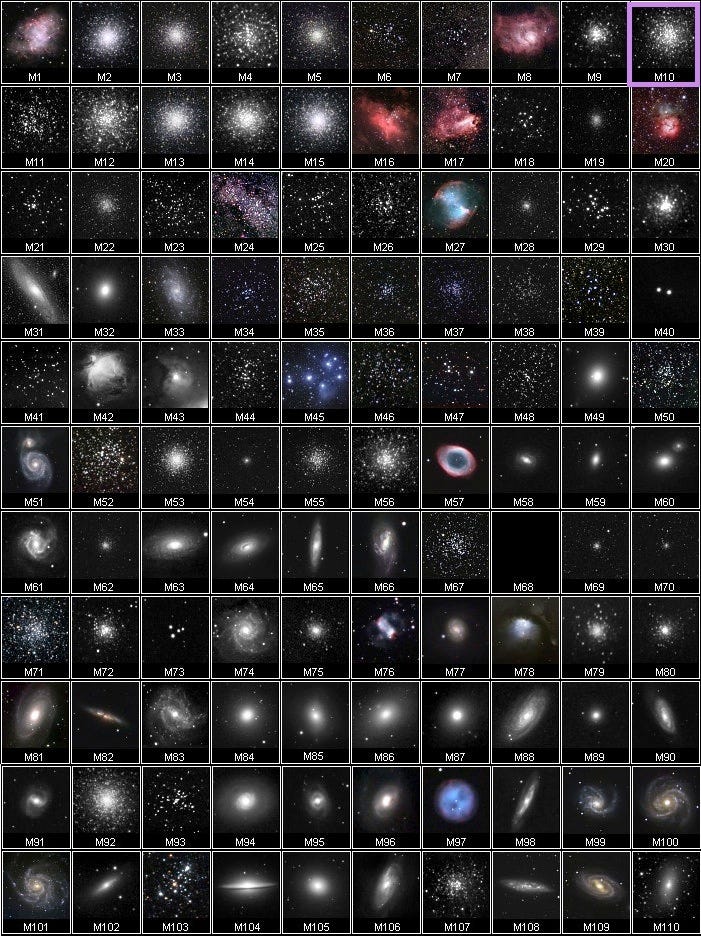
While the extended nebulae and galaxies may be difficult to see on a night with a bright Moon like this one, the stellar and globular clusters are always a treat. Right on the celestial equator, rising over the eastern horizon just a few hours into the night lies the tenth entry in Messier famous catalogue: Messier 10. Here’s how to find it for yourself.
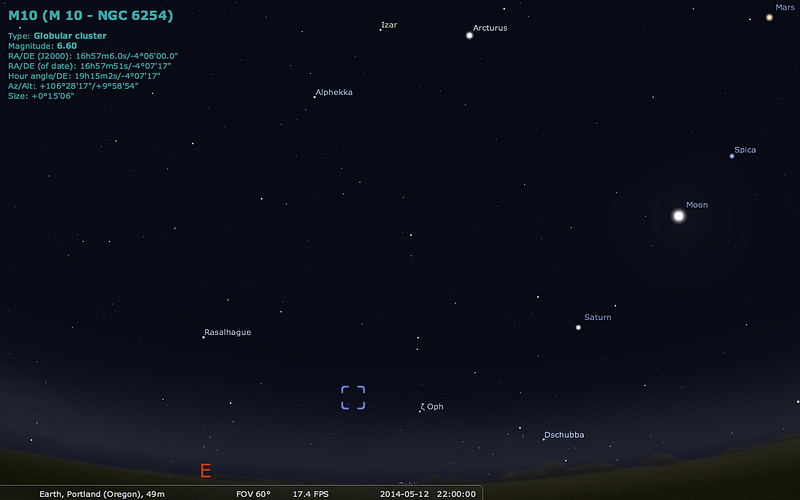
Many regions of the night sky are filled with easily-seen patterns of bright stars, like the Big Dipper, Orion, the Summer Triangle, Leo the Lion or the Teapot in Sagittarius. But what of the deep-sky objects located in regions devoid of such prominent features? For Messier 10, you can follow the (temporary) curve made by connecting bright Mars to blue Spica (through the Moon) to Saturn, and then continuing the arc to two of the brightest stars in the less prominent constellation of Ophiuchus: ζ Ophiuchi (the third brightest) and Rasalhague (the brightest).

There are a few other naked-eye stars that you can see above, but what I want you to notice in particular is that Cebalrai lies just below Rasalhague (closer to the horizon), and that there appears to be a line of four stars connecting Cebalrai to ζ Ophiuchi. They’re not bright stars by any means, but they can be seen with the unaided eye under good skies starting at around 10 PM from most northern latitudes. And if you stop at the third of them moving from Cebalrai to ζ Ophiuchi (or the second, if you’re moving from ζ Ophiuchi to Cebalrai), you’ll find that Messier 10 is right nearby.
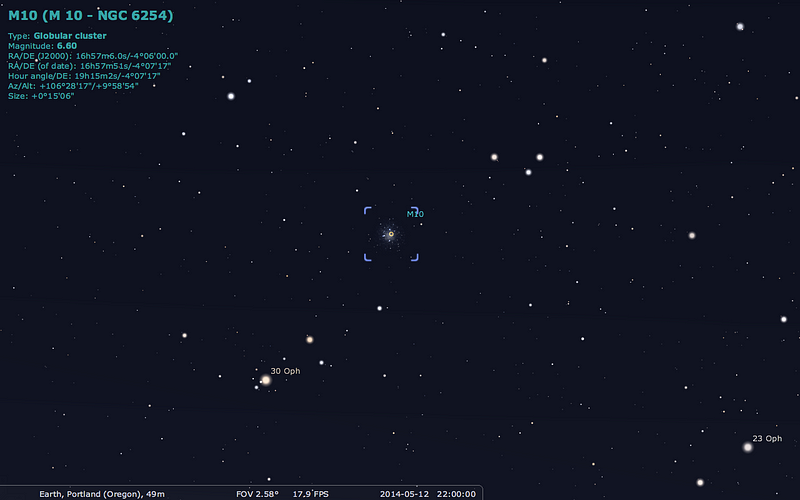
That nearby star is 30 Ophiuchi, and just a single degree away is the rewarding globular cluster M10, today’s Messier object! An original discovery by Messier himself in 1764, he recorded it thus:
Nebula, without stars, in the belt of Ophiuchus, near the 30th star of that constellation, of sixth magnitude, according to Flamsteed. This nebula is beautiful & round; one can only see it with difficulty in an ordinary telescope of 3-feet.
Don’t be too hard on Messier for describing this cluster as such; with his equipment, the image below is probably the best he could have hoped to see.

Messier 10 — at the center of the image above — appears larger and more nebulous than the foreground stars around it, roughly spherical, and a little bigger than its neighboring globular cluster: M12, seen to the upper right. But this is no “nebula without stars,” it’s quite to the contrary a very old cluster with somewhere around 100,000 stars, only appearing so indistinct in small equipment because of the great distances to the stars inside!
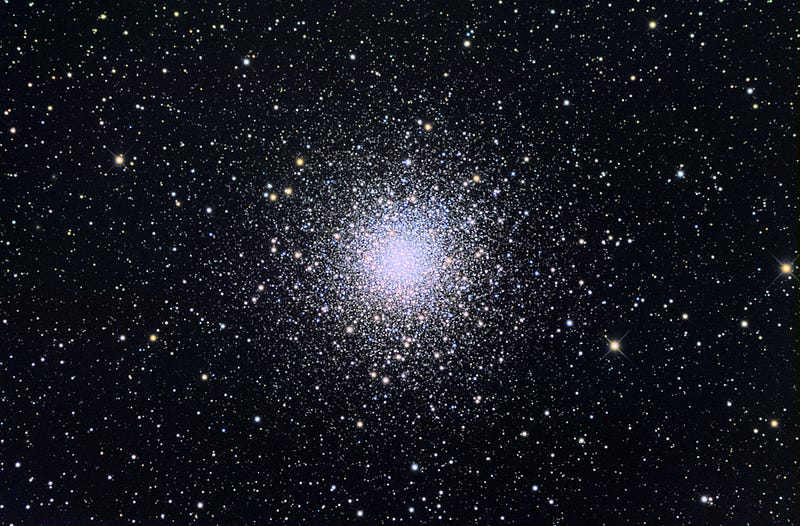
But we can tell an awful lot about this cluster with that modern equipment! First off, you’ll notice that the core of this cluster appears to be significantly denser in terms of the number of stars present than the outskirts. Not only is this true, mind you, but this is how globular clusters are classified: by Shapley-Sawyer Concentration Class. They range from I (most dense at the core) to XII (least dense), with Messier 10 ranking a modest VII.
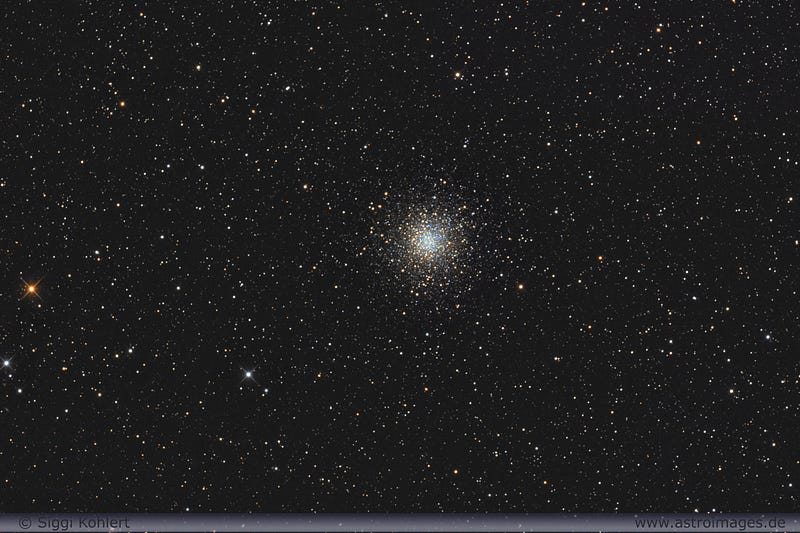
In addition to the core being denser and brighter, there are two other features that distinguish it from the outskirts: one is that there are a much greater number of binary stars in this cluster’s core, with the innermost region consisting of 14% binaries, some ten times as great as the stars at the edge. And the second — as you can tell from the image above — is that there are many blue stars at the core, but very few in the outlying regions! This is because stellar mergers, where two low-mass stars join together, can trigger the formation of a blue straggler star, a common sight in globular clusters, but always preferentially found towards the center!
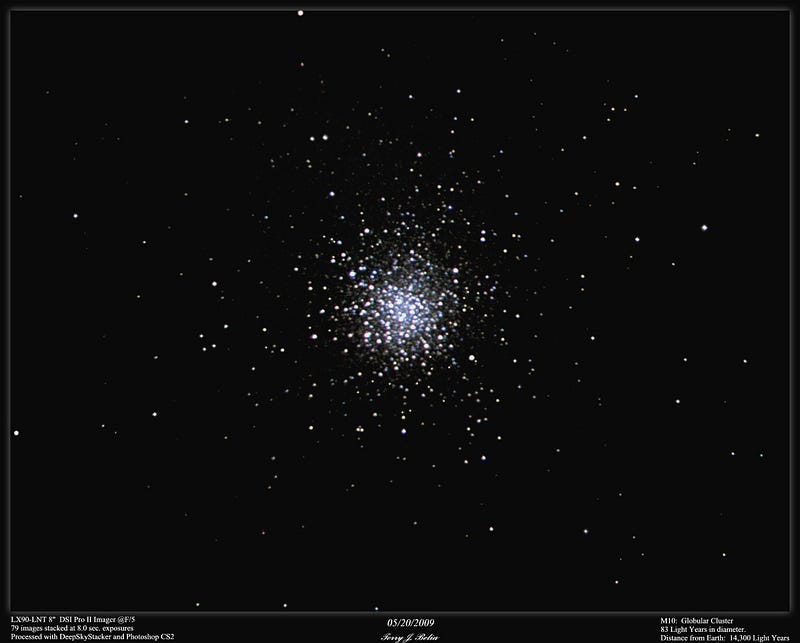
They cluster preferentially inwards over time; their observed positions tell us that the cluster is old, and has been around for a long time. But there’s another, easier way to know that the cluster is old; you look at the heavy elements present inside! The stars in here have just 3.5% of the heavy elements present in the Sun, telling us this cluster formed some 11.4 billion years ago, when the Universe was just 17% its current age. Oddly enough, this puts this globular cluster on the younger side; there are globulars in our galaxy with under 1% our Sun’s heavy element abundance!
You may also notice the difference between an image of M10 like the one above compared with the one below.
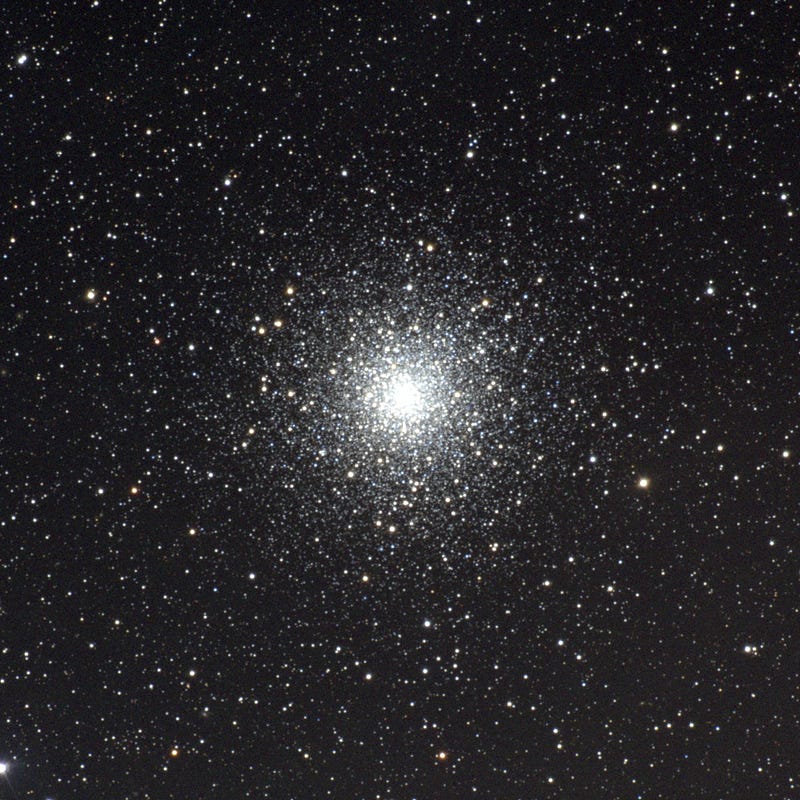
The “bright core” of this globular cluster is maybe 35 light-years in diameter, but the stars within it actually extend out for more than double that: to 83 light-years! This is because the stars on the outskirts are not only less dense in terms of number, but they’re also redder in color and cooler in temperature, making it more challenging for observers with smaller telescopes to see the full extent of the cluster. Check out the difference between Mike Hankey’s view (L) and Mark Jordan’s (R) below!

But using visible light and striving to increase your light-gathering power isn’t the only way to get the most out of this cluster. One fun workaround is to look with optics that are more sensitive to those cool temperatures and long wavelengths: in the infrared!
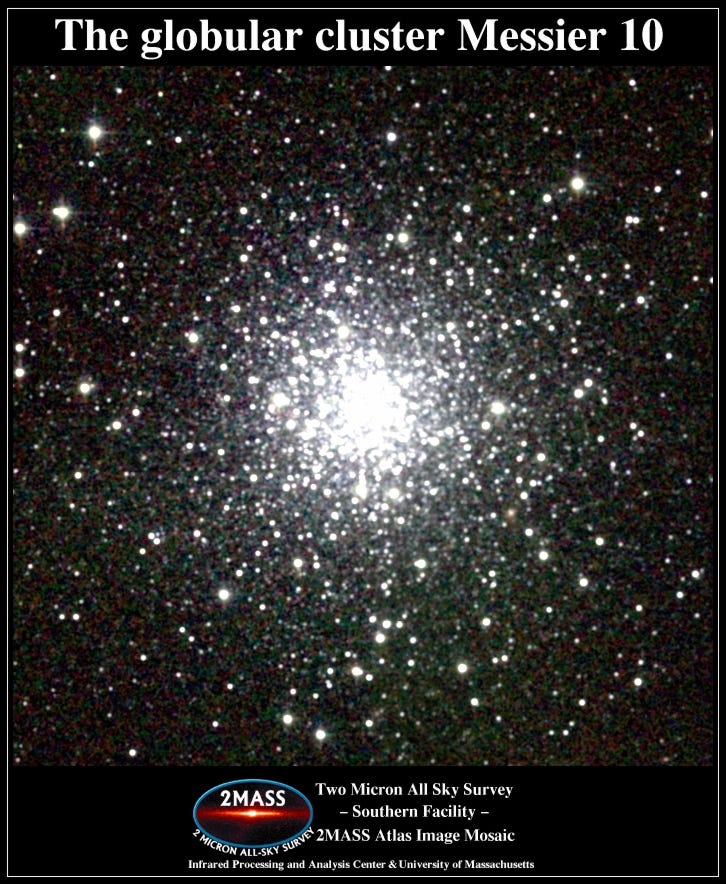
Not only are more stars apparent in an image like this, but the orange-and-red giant stars really pop out in the infrared.
But the star of this cluster is definitely the central core. It will be the last part of this cluster to survive — probably another 15-20 billion years — as it repeatedly passes through the galactic disk and is gravitationally torn apart over timespans of hundreds of passes through the galactic plane. If you lived on a world that had a view of this cluster from maybe 40 light years from the center, this would be what your night sky would look like:
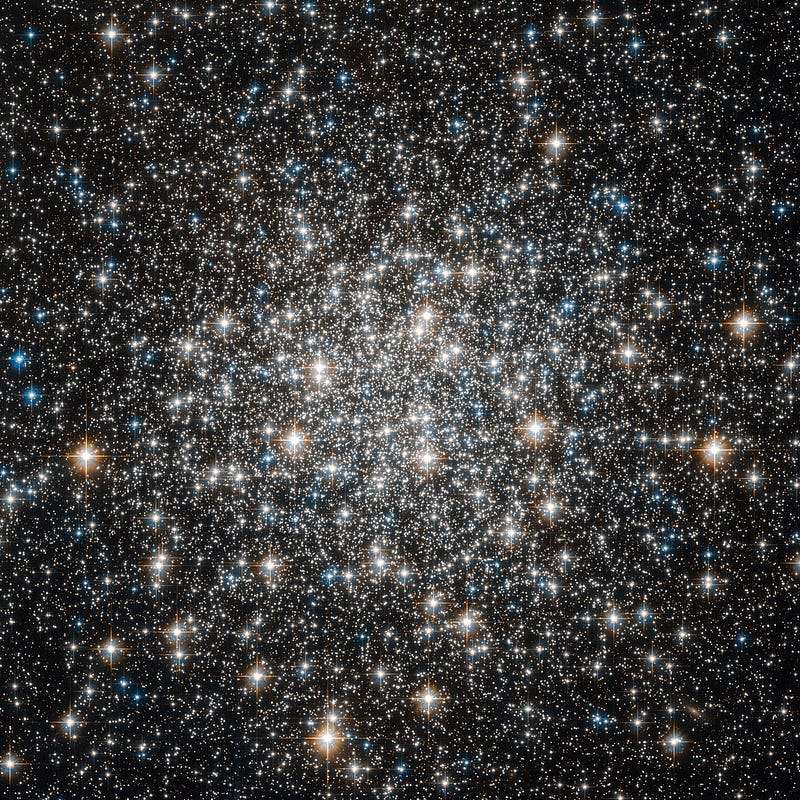
But that might not impress you as much as taking a full-resolution dive through the center of this cluster, courtesy of the Hubble Space Telescope. Like I said, there are around 100,000 stars in this cluster, and just by looking at a strip of the central region, you can come up with an estimate like that for yourself!

Or, as 2001: A Space Odyssey put it so eloquently all those years ago,
“The thing’s hollow — it goes on forever — and — oh my God! — it’s full of stars!”
Yes, yes it is. And that spectacular view will take us to the end of today’s Messier Monday! We’re going to finish all 110 before the year is out, and in the meantime, you can have a look back at our previous Messier Mondays:
- M1, The Crab Nebula: October 22, 2012
- M2, Messier’s First Globular Cluster: June 17, 2013
- M3, Messier’s First Original Discovery: February 17, 2014
- M4, A Cinco de Mayo Special: May 5, 2014
- M5, A Hyper-Smooth Globular Cluster: May 20, 2013
- M7, The Most Southerly Messier Object: July 8, 2013
- M8, The Lagoon Nebula: November 5, 2012
- M10, A Perfect Ten on the Celestial Equator: May 12, 2014
- M11, The Wild Duck Cluster: September 9, 2013
- M12, The Top-Heavy Gumball Globular: August 26, 2013
- M13, The Great Globular Cluster in Hercules: December 31, 2012
- M15, An Ancient Globular Cluster: November 12, 2012
- M18, A Well-Hidden, Young Star Cluster: August 5, 2013
- M20, The Youngest Star-Forming Region, The Trifid Nebula: May 6, 2013
- M21, A Baby Open Cluster in the Galactic Plane: June 24, 2013
- M25, A Dusty Open Cluster for Everyone: April 8, 2013
- M29, A Young Open Cluster in the Summer Triangle: June 3, 2013
- M30, A Straggling Globular Cluster: November 26, 2012
- M31, Andromeda, the Object that Opened Up the Universe: September 2, 2013
- M32, The Smallest Messier Galaxy: November 4, 2013
- M33, The Triangulum Galaxy: February 25, 2013
- M34, A Bright, Close Delight of the Winter Skies: October 14, 2013
- M36, A High-Flying Cluster in the Winter Skies: November 18, 2013
- M37, A Rich Open Star Cluster: December 3, 2012
- M38, A Real-Life Pi-in-the-Sky Cluster: April 29, 2013
- M39, The Closest Messier Original: November 11, 2013
- M40, Messier’s Greatest Mistake: April 1, 2013
- M41, The Dog Star’s Secret Neighbor: January 7, 2013
- M42, The Great Orion Nebula: February 3, 2014
- M44, The Beehive Cluster / Praesepe: December 24, 2012
- M45, The Pleiades: October 29, 2012
- M46, The ‘Little Sister’ Cluster: December 23, 2013
- M47, A Big, Blue, Bright Baby Cluster: December 16, 2013
- M48, A Lost-and-Found Star Cluster: February 11, 2013
- M49, Virgo’s Brightest Galaxy: March 3, 2014
- M50, Brilliant Stars for a Winter’s Night: December 2, 2013
- M51, The Whirlpool Galaxy: April 15th, 2013
- M52, A Star Cluster on the Bubble: March 4, 2013
- M53, The Most Northern Galactic Globular: February 18, 2013
- M56, The Methuselah of Messier Objects: August 12, 2013
- M57, The Ring Nebula: July 1, 2013
- M58, The Farthest Messier Object (for now): April 7, 2014
- M59, An Elliptical Rotating Wrongly: April 28, 2014
- M60, The Gateway Galaxy to Virgo: February 4, 2013
- M61, A Star-Forming Spiral: April 14, 2014
- M63, The Sunflower Galaxy: January 6, 2014
- M64, The Black Eye Galaxy: February 24, 2014
- M65, The First Messier Supernova of 2013: March 25, 2013
- M66, The King of the Leo Triplet: January 27, 2014
- M67, Messier’s Oldest Open Cluster: January 14, 2013
- M68, The Wrong-Way Globular Cluster: March 17, 2014
- M71, A Very Unusual Globular Cluster: July 15, 2013
- M72, A Diffuse, Distant Globular at the End-of-the-Marathon: March 18, 2013
- M73, A Four-Star Controversy Resolved: October 21, 2013
- M74, The Phantom Galaxy at the Beginning-of-the-Marathon: March 11, 2013
- M75, The Most Concentrated Messier Globular: September 23, 2013
- M77, A Secretly Active Spiral Galaxy: October 7, 2013
- M78, A Reflection Nebula: December 10, 2012
- M79, A Cluster Beyond Our Galaxy: November 25, 2013
- M81, Bode’s Galaxy: November 19, 2012
- M82, The Cigar Galaxy: May 13, 2013
- M83, The Southern Pinwheel Galaxy, January 21, 2013
- M85, The Most Northern Member of the Virgo Cluster, February 10, 2014
- M86, The Most Blueshifted Messier Object, June 10, 2013
- M87, The Biggest One of them All, March 31, 2014
- M88, A Perfectly Calm Spiral in a Gravitational Storm, March 24, 2014
- M92, The Second Greatest Globular in Hercules, April 22, 2013
- M93, Messier’s Last Original Open Cluster, January 13, 2014
- M94, A double-ringed mystery galaxy, August 19, 2013
- M95, A Barred Spiral Eye Gazing At Us, January 20, 2014
- M96, A Galactic Highlight to Ring in the New Year, December 30, 2013
- M97, The Owl Nebula, January 28, 2013
- M98, A Spiral Sliver Headed Our Way, March 10, 2014
- M99, The Great Pinwheel of Virgo, July 29, 2013
- M101, The Pinwheel Galaxy, October 28, 2013
- M102, A Great Galactic Controversy: December 17, 2012
- M103, The Last ‘Original’ Object: September 16, 2013
- M104, The Sombrero Galaxy: May 27, 2013
- M105, A Most Unusual Elliptical: April 21, 2014
- M106, A Spiral with an Active Black Hole: December 9, 2013
- M108, A Galactic Sliver in the Big Dipper: July 22, 2013
- M109, The Farthest Messier Spiral: September 30, 2013
We’ve got a grand galaxy planned for you next week, so come on back and don’t miss our next deep-sky wonder on the next Messier Monday!
Have something to say? Leave it at the Starts With A Bang forum on Scienceblogs!





